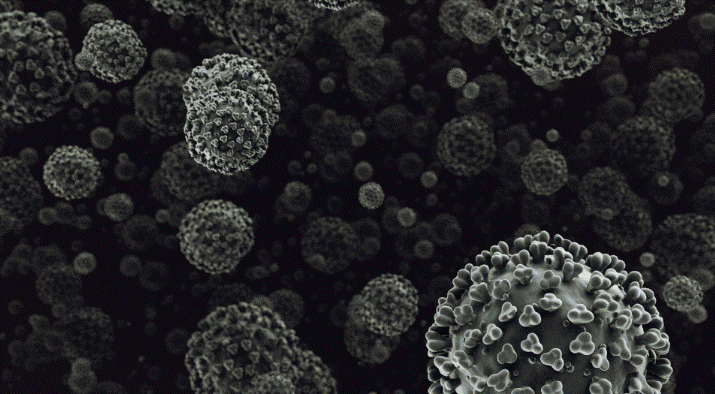CORONAVIRUSES
COVID-19 is the condition generated by the SARS-CoV-2 virus, the latest zoonotic coronavirus to cause an outbreak—in this case, a global pandemic.
Other zoonotic coronaviruses are infamous for causing outbreaks of such severe illnesses as the 2002 severe acute respiratory syndrome (SARS) and the 2012 Middle East respiratory syndrome (MERS).
Zoonotic viruses are viruses that are capable of interspecies transmission and thus can infect humans as well as animals.
Coronaviruses (abbreviated CoV) are a family of viruses that infect humans as well as animals. Coronaviruses got named because their outer proteins look like a crown (corona means “crown” in Latin).
A human coronaviruses infection usually results in mild to moderate symptoms like those of the common cold, including stuffy nose, cough, and sore throat.
The (CDC) Centers for Disease Control and Prevention reported four commonly circulating coronavirus strains: 229E, NL63, OC43, and HKU1.
These strains readily spread around the world each year; most people will get infected with one or more of those coronaviruses during their life.
Rarely, a new human coronavirus appears that causes more severe illness. This type of virus emerges when a coronavirus strain that usually infects only animals crosses the species barrier to infect humans.
Examples of new human coronaviruses that can cause more severe respiratory symptoms to include SARS-CoV, MERS-CoV, and the 2019 novel coronavirus (SARS-CoV-2 or COVID-19).
SARS originated in southern China and first appeared in November 2002. It provoked a worldwide epidemic between 2002 to 2003, resulting in 8,098 possible cases and 774 deaths (9.6% fatalities).
There hasn’t been one SARS case reported since 2004.
MERS-CoV, occasionally known as camel flu, initially emerged in Jeddah, Saudi Arabia, back in 2012 and spread an outbreak of local character to countries surrounding the Arabian Peninsula.
MERS epidemic then spread to another country in the Middle East, then by countries in Asia, North and South America, Europe, and Africa.
MERS infections are still happening, with new cases being confirmed by the WHO recently as March 2021.
Between 2012 and March 2021, the WHO reported 2,586 cases and 939 deaths (34.4% mortality). There were 2 cases of MERS reported in the United States in 2014, but none since that date.
INITIAL COVID-19 CASES
Although the origin of COVID-19 has been called into question, a cluster of 27 cases of so-called viral pneumonia of unknown origin, some of which were severe and not responding to conventional treatment, were reported to China’s National Health Commission (NHC) on December 30, 2019.
Most of the people initially infected were vendors at the Huanan Seafood Wholesale Market in Wuhan, China, where they were selling life or recently killed fish, birds, and other animals.
The seafood market was closed on January 1, 2020, for cleaning and disinfection. Officials have yet to determine the animal species that initially conveyed the virus to humans.
It is possible that the novel virus first emerged as early as October 2019.
An early genomic analysis published in The Lancet on January 29, 2020, showed up to 99% sequence identity between ten SARS-CoV-2 genome sequences from nine patients in Wuhan, eight of whom had visited the Huanan Seafood Wholesale Market.
This early analysis also observed that SARS-CoV-2 is closely related to two other bat-derived SARS-like coronaviruses (88% sequence identity), suggesting that bats may be the original reservoir of the virus.
NEW VARIANTS OF COVID-19
All viruses mutate frequently, and COVID-19 is no exception.
As of April 2021, the CDC, NIH, FDA, and several other U.S. government agencies have developed a three-level classification for variants of the COVID-19 virus:
- Variants of interest (VOIs): These are variants with specific genetic markers that may affect the speed of transmission of the virus, weaken the effectiveness of vaccines or antibodies, or reduce the effectiveness of treatments for COVID-19. VOIs circulating in the United States as of April 2021 include B.1.526, B.1.526.1, B.1.525, and P.2.
- Variants of concern (VOCs): These are variants of the virus with evidence of causing more severe disease, significantly reducing the effectiveness of vaccines or treatments, or being more readily transmissible. The B.1.1.7, B.1.351, P.1, B.1.427, and B.1.429 alternatives circulating in the United States are classified as variants of concern as of April 2021.
- Variants of high consequence (VOCs): These are variants of the COVID-19 virus, with clear evidence that preventive measures or medical treatments have significantly reduced effectiveness relative to previously known variants. A VOHC would require notification to the WHO, reporting to the CDC, public announcement of strategies to prevent or contain the transmission, and recommendations for updating treatments and vaccines. No VOHCs are circulating in the United States as of April 21.
Definitions and other information about COVID-19 variants can be found at https://www.cdc.gov/coronavirus/2019-ncov/cases-updates/variant-surveillance/variant-info.html.
TRANSMISSION OF COVID-19
Although the initial group of people infected with COVID-19 was believed to have been infected by animals from the Huanan market, human-to-human transmission has since been verified worldwide.
Like other respiratory illnesses, COVID-19 is transmitted via respiratory droplets or aerosols when infected talk, sings, coughs, or sneezes.
A new infection occurs when either respiratory droplets or aerosols exhaled by an infected person enter the mouth, nose, or eyes of other people who are in close contact with the infected person.
There is, however, no evidence as of early 2021 that COVID-19 can be transmitted by skin-to-skin contact.
As found in a new research study reported in the Annals of Internal Medicine in November 2020, roughly a third of people with COVID-19 show no symptoms.
These people can unknowingly spread the disease due to their lack of symptoms (asymptomatically) or extend the illness before developing symptoms (pre-symptomatically).
People may transmit the virus to others as early as two days before they develop symptoms themselves.
This finding urged the CDC to recommend that the ordinary public wear cloth face masks in public where social distancing is hard to maintain, such as in grocery stores and pharmacies.
The primary reproduction number (also called R0, pronounced R-nought or R-zero) of a germ is how one sick person infects most people on average.
The larger the number, the more infectious the virus is. In common, a number higher than one usually means an epidemic will go higher.
While the actual reproduction number is constantly changing according to the latest information, the WHO estimates a preliminary R0 of 2.0 – 2.5 for COVID-19.
This number means that up to 2.5 people can be infected by every one person infected with COVID-19.
For comparison, the transmission rate of SARS-CoV was estimated to be 2 to 3; that of common influenza strains is around 1.3; and of measles virus (highly contagious), between 12 and 15.
COVID-19 PREVENTION
Personal measures
The best method to slow the spreading of the coronaviruses and prevent infection is to minimize social and physical contact with people you don’t live with and, when you have to go out in public, put on a face mask and keep at least six feet away from other people.
Other measures to take include:
- Wash your hands regularly and entirely with soap and water for 20 seconds
- Using an alcohol-based hand sanitizer that is above 60% alcohol if you unable to wash your hands (or on top of hand washing)
- Avoid touching your eyes, mouth, and nose
- Cleaning and disinfecting things repeatedly
- Avert close contact with people who are sick
- Staying home if you are sick
- Getting an annual flu shot
- Receiving an FDA-approved COVID-19 vaccine
Everyone who has been subjected to someone who is known to be infected with COVID-19 should do self-quarantine for two weeks, as recommended by the CDC since April 2021.
Nevertheless, the CDC confirms that some local public health authorities can permit people to quit quarantine after ten days with no mandatory testing. After day 7, having negative test results, the test was done on day five or later.
Due to the active community transmission of COVID-19 in the United States, initial guidelines called “15 Days to Slow the Spread” were issued on March 16, 2020.
Those guidelines were extended for an additional 30 days on March 31, 2020, and grown in most states as of April 2021.
The guidelines outline the following precautions that should be followed by all Americans (and anyone in a country currently experiencing COVID-19 community spread).
If you are healthy and in a region of active transmission, you should take additional precautions, such as:
- Practicing social distancing by minimizing contact with others and staying at least 6 feet away from others
- Avoiding crowds and public places; stay home as much as possible (work and complete schoolwork at home)
- Avoiding discretionary travel, shopping, and social visits
- Avoiding eating in restaurants and bars; use the drive-thru, pickup, or delivery option instead.
- Avoiding visiting nursing homes, retirement facilities, and long-term care facilities
- You are wearing a cloth face mask (but be sure to use it correctly by washing your hands before putting the cover on, keeping the mask over your mouth and nose while among the people, never touching the front of the surface, and washing the mask after every use). People must also wear masks when traveling on airplanes, buses, trains, and all other forms of public transportation in the United States.
- Receiving an FDA-approved COVID-19 vaccine
People in the following high-risk groups should take the following further precautions:
- If you are an older individual or a person with underlying health conditions (such as diabetes, heart disease, asthma, a weakened immune system, etc.), stay at home and stay away from other people.
- If you or someone inside your house is sick, hold the whole household at home and talk to your medical provider—do not go to work or school.
- Should you or another member of your family tested positive for COVID-19, keep the entire household at home and give a call to your medical provider—do not go to work or school.
Animal care measures
Since April 2021, the chance of such household pets as dogs and cats spreading COVID-19 to the human population is thought to be low;
nevertheless, there is specific evidence that humans can advance the virus to dogs and also cats, with cats seemingly being more vulnerable than dogs.
To stay on the safe side, persons ill with COVID-19 should be confined from pets and others in the family; and pets should not be permitted to contact anyone outside the household.
Cats should be held strictly indoors. Last but not least, people should not put masks on their pets as it can harm pets.
Albeit the FDA has not issued a EUA to this date for an animal COVID-19 vaccine, the Russian government declared on March 31, 2021, that it had successfully registered the first vaccine suitable for animals.
State-level changes in masking mandates
Although the CDC still recommends the use of masks to slow down the spreading of COVID-19 (see https://www.cdc.gov/coronavirus/2019-ncov/prevent-getting-sick/cloth-face-cover-guidance.html for the most up to date instructions), 13 states have started to lift mask mandates for the common public since April 2021: 10 states by order of the governor (Alabama, Indiana, Arkansas, Mississippi, Iowa, Montana, North Dakota, New Hampshire, Wyoming, and Texas); two by legal action (Kansas and Utah); and also one by court order (Wisconsin). Details specifying each state or territory’s mask mandate as of April 23, 2021, can be found https://www.aarp.org/health/healthy-living/info-2020/states-mask-mandates-coronavirus.html.
Vaccines
As of April 26, 2021, there are 3 COVID-19 vaccines licensed by the Food and Drug Administration (FDA) for implementation in the United States:
- The Pfizer-BioNTech vaccine (also known ad tozinameran) for persons 16 years or older.
- The Moderna-vaccine (also called mRNA-1273) for persons 18 years and older.
- The Johnson & Johnson COVID-19 vaccine (also known as Ad.26.COV2.S or the Janssen COVID-19 vaccine) for people 18 years and older.
The CDC does not recommend any of the vaccines over the others; all are considered equally acceptable to protect individuals and the general public.
The first two vaccines are applied as two shots 28 days apart in the muscle of the upper arm.
Those vaccines are mRNA vaccines (also known as genetic-code vaccines), meaning that they use a copy of messenger RNA to make an immune response in the recipient; they are not using the live virus which generates COVID-19.
An individual is deemed to be fully vaccinated two weeks after receiving the second application.
The Johnson & Johnson vaccine is called a viral vector vaccine; it uses a virus that is not causing the illness to carry genetic material from the illness-causing virus to provoke an immune response.
Dissimilar to the two mRNA vaccines, the Johnson & Johnson vaccine takes only one dose. Its extra benefit is that it does not have the requirement to be transported frozen and stays viable in a standard refrigerator for a couple of months.
Although the CDC shortly paused the Johnson & Johnson vaccine administration on April 13, 2021, Johnson & Johnson application was continued on April 23.
An individual is considered fully vaccinated two weeks after receiving the single dose of this vaccine.
According to the CDC, in extensive Phase, three trials of the AstraZeneca COVID-19 vaccine (AZD1222) and the Novavax COVID-19 vaccine are ongoing in the United States since April 2021.
The AstraZeneca cure is a viral vector vaccine, and the Novavax vaccine, otherwise known as NVX-CoV2373, is a protein subunit vaccine. Both vaccines require two doses for the total effect.
Another COVID-19 vaccine approved for use by other countries as of late April 2021:
- Viral vector vaccines. Those vaccines use a chemically weakened virus to move fragments of the disease virus to stimulate an immune reaction. They involve Gam-COVID-Vac, refined in Russia; AD5-nCoV (Convidecea), refined by the Chinese Academy of Military Medical Sciences; and AZD1222, refined by AstraZeneca and the University of Oxford. Administration of the AstraZeneca vaccine was stopped briefly at the beginning of March 2021 in Germany, France, Spain, and Italy thanks to fears that it could be tied with uncommon blood clots in specific recipients. The European Medicines Agency (EMA) claims that the vaccine’s benefits outweigh the risks; nevertheless, and administration resumed on March 18, 2021. As noted above, this vaccine is currently put to trial tests in the United States for likely approval by the FDA.
- Inactivated virus vaccines. These include CoronaVac and BBIBP-CorV, refined by Chinese pharmaceutical companies and government institutes; CoviVac, refined by the Russian Academy of Sciences; and BBV152 (Covaxin), refined by the Indian Council of Medical Research.
- Protein subunit vaccines. These include EpiVacCorona, refined by the Vector Institute in Russia, and RBD-Dimer (ZF2001), refined by the Chinese Academy of Sciences.
Since April 26, 2021, over 1.03 billion doses of COVID-19 vaccines had been applied globally, corresponding to official national health agencies; with the same date, the CDC stated that 230,768,454 Americans had received the initial dose of an approved COVID-19 vaccine.
In Dec. 2020, once the supply of approved vaccines was restricted, the CDC issued lead recommendations for the United States as follows:
- Phase 1a: health care staff and residents of long-term care facilities.
- Phase 1b: crucial frontline workers (firefighters, police officers, corrections officers, food and agricultural workers, public transit workers, manufacturing workers, United States Postal Service workers, grocery store workers, support staff and teachers, and daycare workers) also adults over 75 years old.
- Phase 1c: Adults between 65 to 74 years old; people between 16 and 64 years old with hidden health problems; and individuals whose jobs are in transportation and logistics, law, media, food service, information technology, housing construction and finance, communications, energy, public safety, and public health.
The CDC updated these preference proposals in April 2021 to state that all Americans being 16 years old or older are now eligible for vaccination even though the supply of vaccines is still limited as of today.
People should consult their local health department for comprehensive information on vaccine administration in their region.
People may also check on a website named VaccineFinder
(https://vaccinefinder.org/search/) to pinpoint locations where they can arrange appointments to get a particular COVID-19 vaccine; the CDC also suggests contacting one’s regional pharmacy.
At the end of April 2021, the federal government is active in making all FDA-approved vaccines universally available to anyone at no cost at all.
The vaccines licensed for usage in the United States are safe for most people.
Nevertheless, some persons should not receive these vaccines, and sure others should talk to their health care worker:
- The CDC advocate that people who have had short allergic responses to either of the elements in the COVID-19 vaccines should not take the vaccination. Individuals who have had a serious allergic response to other vaccines should talk to a physician before receiving the COVID-19 vaccines. Since April 2021, individuals who do not have a history of allergic responses to vaccines are noticed for 15 minutes after receiving the shot; people who have such a history are kept for 30 minutes afterward. Everyone who has a harsh allergic response to the first COVID-19 vaccine shot is recommended not to get the 2nd shot.
- Child-bearing and lactation: Pregnant and lactating women were excluded from the COVID-19 vaccine trials, so little data about the vaccine’s safety in this community. The CDC, nevertheless, considers infection with COVID-19 to be a more significant risk to childbearing women and their unborn offspring than potential risks connected with the vaccine.
- Kids and younger teenagers: Kids were excluded from the initial COVID-19 vaccine trial tests. Trials tests of the vaccines’ safety and influence in children started in March 2021, with data ready in early summer.
- Individuals with a positive test for COVID-19: Those who indicated the illness should wait a moment until they have met all criteria to suspend isolation to get the vaccine. Persons who received antibody treatment against the virus should wait 90 days before getting vaccinated.
- Immuno-compromised persons: Subjects with HIV infection or exhausted immune systems should discuss the risks and benefits of vaccination with their physician before receiving a COVID-19 vaccine. Since April 23, 2021, the CDC has posted updated information for specific groups of people https://www.cdc.gov/coronavirus/2019-ncov/vaccines/recommendations/specific-groups.html.
Travel advisories
Since April 2021, the CDC still recommends that people avoid all nonessential travel, while those who are eligible should be entirely vaccinated before traveling.
U.S. travel advisories were first issued in late January 2020 with mainland China (where most cases were at the time) and extended to include other countries as they began reporting increasing COVID-19 chances.
In April 2021, the CDC added a list of countries grouped by a risk assessment of COVID-19 transmission from high to high, moderate, low, and unknown. This list can be obtained at https://www.cdc.gov/coronavirus/2019-ncov/travelers/map-and-travel-notices.html.
The U.S. Department of State advises that overseas U.S. citizens who wish to return to the U.S. should contact the nearest U.S. embassy or consulate for travel assistance.
The most recent CDC guidelines for travel can be found at https://www.cdc.gov/coronavirus/2019-ncov/travelers/index.html.
International travelers returning to the U.S. should follow the guidelines at https://www.cdc.gov/coronavirus/2019-ncov/travelers/after-travel-precautions.html. Even fully vaccinated travelers should take the CDC’s recommended precautions after returning to the United States.
Domestic travel: Masks are required on airplanes, trains, buses, and other methods of general transportation traveling in, within, or out of the United States and in such U.S. transportation hubs like airports and bus or train stations.
SYMPTOMS OF COVID-19 INFECTION
Symptoms of more common coronaviruses are similar to other upper respiratory infections, including stuffy nose, runny nose, sore throat, cough, and sometimes fever.
Symptoms of COVID-19, however, range from very mild to severe upper respiratory symptoms.
The CDC says that moderate to severe symptoms can include fever, cough, runny nose, sore throat, difficulty breathing, shortness of breath, muscle pain, and tiredness.
Other symptoms of COVID-19 infection can include nausea or vomiting, diarrhea, loss of the senses of taste and smell, and headache.
About 15 to 20% of cases so far have become severe, according to the WHO.
Symptoms can appear anywhere from 2 to 14 days after exposure to the virus, with the average being around five days. Symptoms tend to be soft in the beginning and gradually worsen over a few days.
The infection can spread to the lower respiratory tract and cause pneumonia, which is the primary cause of severe illness and death.
Pneumonia is more common in older people, infants, people with weakened immune systems, and people with underlying conditions such as heart disease.
You should ask for medical attention urgently if you have any of the following severe signs of COVID-19, per the CDC:
- Trouble breathing
- Persistent pain or pressure in the chest
- Confusion (spatial disorientation; loss of average mental clarity; inability to recognize time, place, or one’s identity)
- Difficulty waking up or staying awake
- Bluish lips or face.
The CDC advises anyone caring for a person with these symptoms to call 9-1-1 and notify the operator that care is needed for a person who has or may have COVID-19.
DIAGNOSIS
There are two significant categories of testing for COVID-19: diagnostic (to test whether a person is presently infected); and antibody testing (to detect antibodies to the virus as evidence of past infection).
Diagnostic testing uses two laboratory methods: molecular (reverse transcription-polymerase chain reaction or RT-PCR) testing or antigen testing.
Antibody testing is done on a blood sample. Diagnostic testing requires collecting a nasal swab and a throat swab; sometimes, a saliva sample may be collected.
Antibody testing requires a blood sample drawn from a vein or collected from a fingerstick. Neither type of testing requires any preparation on the patient’s part.
Diagnostic kits for SARS-CoV-2 were made available by the CDC on February 4, 2020, to ship to qualified U.S. and international laboratories.
As of April 2021, the FDA has issued EUAs for more than 80 different diagnostic tests for COVID-19.
In some cases, patients must go to their physician or an authorized testing center to be tested for the virus; however, as of April 2021, the FDA has approved several test kits for the virus’s antigen that allow a person to collect a nasal sample at home and then send it to a certified laboratory for analysis.
Some of these tests require a doctor’s prescription, but at least one does not. The user must first download the appropriate application (app) for a smartphone to use these antigen tests.
In addition, the Lab Tests Online website has added a link to HealthTestingCenters.com (https://www.healthtestingcenters.com) that allows people to order COVID-19 tests online or over the telephone.
TREATMENT
There is currently only one FDA-approved coronavirus-specific antiviral treatment: remdesivir for COVID-19.
The treatment for most coronaviruses is similar to cure for the common cold: rest, fluids, and such over-the-counter medications as acetaminophen and NSAIDs for fever, sore throat, and body aches.
More seriously ill patients may require hospitalization to relieve their symptoms and ensure their organs are functioning correctly.
The CDC recommends treating dexamethasone (a corticosteroid medication) for patients with low oxygen levels thanks to an overactive immune response to the virus.
There is some evidence that vitamin D deficiency increases the risk of a severe course of COVID-19 in infected persons, particularly those of Black or Asian origin.
Several clinical trials underway identify any specific role for vitamin D in COVID-19 prevention and management.
COVID-19 DRUG DEVELOPMENT
The only drug currently approved by the Food and Drug Administration (FDA) to treat COVID-19 is remdesivir (Veklury), an antiviral agent approved by the FDA on October 22, 2020.
Other currently available drugs are being repurposed to see whether they are effective against SARS-CoV-2; these include nitazoxanide, ivermectin, and niclosamide.
Investigational antiviral drugs include molnupiravir and favipiravir; investigational immune modulator drugs include infliximab (Remicade), abatacept (Orencia), cenicriviroc, and tocilizumab.
On June 15, 2020, the FDA revoked the emergency use authorization (EUA) of hydroxychloroquine and chloroquine to treat COVID-19.
The agency reported that “these medicines showed no benefit for decreasing the likelihood of death or speeding recovery.”
On July 4, 2020, WHO discontinued its trials of hydroxychloroquine and lopinavir/ritonavir for the same reasons.
Other drugs made available to treat COVID-19 under the FDA’s Emergency Use Authorization (EUA) as of April 2021 include:
- Casirivimab/imdevimab: This treatment is a drug “cocktail” of two monoclonal antibodies. It was given a EUA on November 21, 2020, to treat nonhospitalized patients with confirmed COVID-19 experiencing mild to moderate symptoms at high risk of severe symptoms and hospitalization.
- Baricitinib in combination with remdesivir: Baricitinib is a kinase inhibitor used to treat rheumatoid arthritis. The FDA issued a EUA on November 19, 2020, for the use of this combination in hospitalized COVID-19 patients aged two years and older who require supplemental oxygen, invasive mechanical ventilation, or extracorporeal membrane oxygenation.
- Bamlanivimab plus etesevimab: Both these drugs are monoclonal antibodies. The FDA gave the combination of bamlanivimab and etesevimab a EUA on February 8, 2021, to treat mild to moderate COVID-19 in adults and children 12 years and older who are at high risk of progressing to severe disease. The FDA revoked an earlier EUA for the use of bamlanivimab alone on April 16, 2021.
Convalescent plasma: Convalescent plasma is plasma taken from the blood of adults who have recovered from COVID-19; it contains antibodies to the virus.
Clinical trials of convalescent plasma began in April 2020. On August 23, 2020, the FDA issued a EUA to use convalescent plasma in treating patients with COVID-19.
As of March 19, 2021, the CDC states that there is not enough evidence to recommend this treatment.
Other investigational treatments for COVID-19: The search for effective treatments for the disease is complex, with several types of drug therapies (antibodies, antivirals, cell-based therapies, RNA-based treatments, and repurposed drugs) under investigation.
As of late April 2021, at least 326 different drugs are being tested worldwide as possible COVID-19 treatments, according to the Milken Institute.
Readers can find the most recent updates on investigational drugs at the Milken Institute link listed under the website resources below.
COVID-19 VACCINE DEVELOPMENT
Noninjectable immunizations against COVID-19 are under development, along with injectable vaccines.
Although these newer types of vaccines are only in Phase 1 trials as of April 2021, candidates include two intranasal vaccines (MV-014-212 and AdCOVID); two oral vaccines (hAd5 T-cell and VXA-CoV2-1); two orally inhaled vaccines (saRNA inhaled and ChAdOx1 nCov-19); and one administered by microneedle (PittCoVacc) developed at the University of Pittsburgh.
As of April 2021, the following injectable COVID-19 vaccines have not yet been approved for administration in any country but are in late-stage development:
- Viral vector vaccines: These include IIBR-100, developed by the Israel Institute for Biological Research, and GRAd-COV2, designed by Italy’s national institute for infectious diseases.
- Virus subunit vaccines include the Novavax vaccine (also called NVX-CoV2373), which uses recombinant nanoparticle technology from the SARS-CoV-2 genetic sequence, an antigen derived from the coronavirus spike protein. As noted earlier, this vaccine is undergoing trials in the United States for possible authorization by the FDA.
- Genetic-code vaccines: CVnCoV (zoricimeran), developed by a German biopharmaceutical company; and Lunar-COV19/ARCT-021, developed by the American biotechnology company Arcturus.
- Plant-based virus-like particle vaccines: The only vaccine in this category to date is CoVLP, developed by a Canadian biotechnology company.
- Inactivated virus vaccines: These include VLA2001, developed by a biotechnology company headquartered in France.
Readers can find the most recent updates on COVID-19 vaccines at the New York Times link listed under website resources below.
STATISTICAL DATA ON THE COVID-19 PANDEMIC
For regularly updated COVID-19 data, please see the following sources:
- “CDC COVID Data Tracker.” Centers for Disease Control and Prevention (CDC). https://covid.cdc.gov/covid-data-tracker
- “Coronavirus Map: Tracking the Global Outbreak.” The New York Times. https://www.nytimes.com/interactive/2020/world/coronavirus-maps.html
- “Coronavirus Update (Live).” Worldometer. https://www.worldometers.info/coronavirus/
- “COVID-19 Global Map.” Johns Hopkins Coronavirus Resource Center. https://coronavirus.jhu.edu/map.html
- “Coronavirus Variant Tracker.” Axios. https://www.axios.com/coronavirus-variant-tracker-where-different-strains-are-spreading-ffd71934-1596-43e6-923d-32c4698e2f8b.html
- “Genomic epidemiology of novel coronavirus—Global subsampling.” Nextstrain.org. https://nextstrain.org/ncov/global
- “What’s New and Updated.” Centers for Disease Control and Prevention (CDC). This is a new landing page on the CDC COVID-19 website to help people stay current with significant changes in guidance and information about the pandemic. Readers can filter the content by topic, type, or intended audience. The page is updated daily: https://www.cdc.gov/coronavirus/2019-ncov/whats-new-all.html.
- “WHO Coronavirus Disease (COVID-19) Dashboard.” The World Health Organization. https://covid19.who.int
Resources
Websites
Bergman, Scott J. “Treatment of Coronavirus Disease 2019 (COVID-19): Investigational Drugs and Other Therapies.” Medscape Reference. Updated April 19, 2021. https://emedicine.medscape.com/article/2500116-overview (accessed April 26, 2021).
Cennimo, David J. “COVID-19 Vaccines.” Medscape Reference. Updated April 14, 2021. https://emedicine.medscape.com/article/2500139-overview (accessed April 26, 2021).
“Coronavirus (COVID-19) Testing.” Lab Tests Online. April 20, 2021. https://labtestsonline.org/tests/coronavirus-covid-19-testing (accessed April 26, 2021).
“Coronavirus Disease 2019 (COVID-19): Frequently Asked Questions.” Centers for Disease Control and Prevention (CDC). Updated April 2, 2021. https://www.cdc.gov/coronavirus/2019-ncov/faq.html (accessed April 26, 2021).
“Coronavirus disease (COVID-19) pandemic.” World Health Organization. Updated April 26, 2021. https://www.who.int/emergencies/diseases/novel-coronavirus-2019 (accessed April 26, 2021).
“Coronavirus Symptoms: Frequently Asked Questions.” Johns Hopkins Medicine. Updated February 24, 2021. https://www.hopkinsmedicine.org/health/conditions-and-diseases/coronavirus/coronavirus-symptoms-frequently-asked-questions (accessed April 26, 2021).
“COVID-19.” HealthyChildren.org. https://healthychildren.org/English/health-issues/conditions/COVID-19/Pages/default.aspx (accessed April 26, 2021).
“COVID-19: Coronavirus Disease 2019.” Public Health Emergency. April 16, 2021. https://www.phe.gov/emergency/events/COVID19/investigation-MCM/Pages/default.aspx (accessed April 26, 2021).
“COVID-19 Real-Time Learning Network.” Infectious Diseases Society of America. Updated daily. https://www.idsociety.org/covid-19-real-time-learning-network/ (accessed April 26, 2021).
“COVID-19 Treatment and Vaccine Tracker.” Milken Institute, FasterCures Center. Updated April 25, 2021. https://covid-19tracker.milkeninstitute.org (accessed April 26, 2021).
Ferran, Maureen. “How does the Johnson & Johnson vaccine compare to other coronavirus vaccines? 4 questions answered.” The Conversation. February 27, 2021. https://theconversation.com/how-does-the-johnson-and-johnson-vaccine-compare-to-other-coronavirus-vaccines-4-questions-answered-155944 (accessed April 26, 2021).
“Timeline of WHO’s response to COVID-19.” World Health Organization. https://www.who.int/emergencies/diseases/novel-coronavirus-2019/interactive-timeline (accessed April 26, 2021).
“Understanding mRNA COVID-19 Vaccines.” Centers for Disease Control and Prevention. Updated March 4, 2021. https://www.cdc.gov/coronavirus/2019-ncov/vaccines/different-vaccines/mrna.html (accessed April 26, 2021).
Zimmer, Carl, Jonathan Corum, and Sui-Lee Wee. “Coronavirus Vaccine Tracker.” New York Times. Updated April 26, 2021. https://www.nytimes.com/interactive/2020/science/coronavirus-vaccine-tracker.html (accessed April 26, 2021).
Organizations
European Centre for Disease Prevention and Control (ECDC), Gustav III:s Blvd 40, Solna, Sweden, 16973, +46 85 860-1000, Fax: +46 85 860-1001, [email protected], https://www.ecdc.europa.eu/en/home .
Infectious Diseases Society of America (IDSA), 4040 Wilson Boulevard, Suite 300, Arlington, VA, 22203, (703) 299-0200, https://www.idsociety.org/contact-us/, https://www.idsociety.org/.
Milken Institute, FasterCures Center, 730 15th St NW, Washington, DC, 20005, (202) 336-8900, Fax: (202) 336-8902, [email protected], https://milkeninstitute.org/centers/fastercures .
National Institute of Allergy and Infectious Diseases, National Institutes of Health, 5601 Fishers Ln, MSC 9806, Bethesda, MD, 20892-9806, (301) 496-5717, (866) 284-4107 or TDD (800) 877-8339 (for hearing impaired), Fax: (301) 402-3573, [email protected], https://www.niaid.nih.gov/ .
U.S. Centers for Disease Control and Prevention (CDC), 1600 Clifton Rd, Atlanta, GA, 30333, (800) CDC-INFO (232-4636), http://www.cdc.gov/cdc-info/requestform.html, http://www.cdc.gov.
U.S. Food and Drug Administration (FDA), 10903 New Hampshire Ave., Silver Spring, MD, 20993, (888) 463-6332, https://www.fda.gov/.
World Health Organization, Ave Appia 20, Geneva 27, Switzerland, 1211, +41 22 791-2111, Fax: +41 22 791-3111, https://www.who.int/ .








